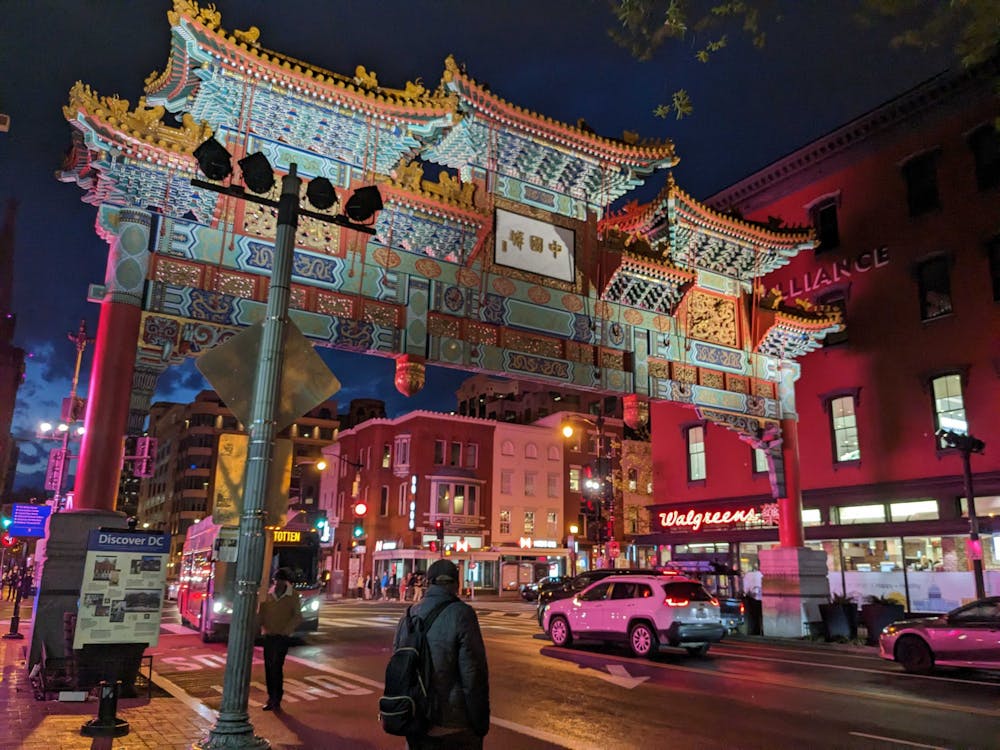The crisp air, the petrichor. Nothing feels quite as refreshing as rain after a hot, muggy day, which is simply a positive way to say I got caught in a heavy downpour on a Thursday afternoon and was cold and wet while on my hunt for dim sum in Chinatown.
I’d do anything to satisfy my dim sum cravings.
As a person of Sichuanese heritage, I am beyond grateful for our local Orient Express. Although the restaurant has mixed reviews and inconsistency with their dishes, I enjoy the taste of home when I order deep-fried green peppers, hot and sour rice noodles and — my favorite — spicy boiled fish (called “Poached Sliced Fish in Hot Chili Sauce” on their menu). Orient Express has never failed me with those dishes before.
But I also grew up with Cantonese culture on my mother’s side. Back home, I enjoyed bowls of sago soup (sai mai lou in Cantonese), pan-fried turnip cakes and Malay sponge cakes, all of which I cannot get in Baltimore. Let’s face it: It’s difficult to get a variety of good Chinese cuisine in Baltimore and its non-existent Chinatown. The closest thing to sago soup I’ve tried in Baltimore is the Coconut Bubble Ruda at Water Song Yunnan Kitchen in Federal Hill. But even that had the tapioca pearls clumped together and had an existential crisis between being sago soup or a South Asian treat called falooda. However, I do recommend their hot pot and zajiang noodles.
It wasn’t always like this. While most early Chinese immigrants to the U.S. came as railroad workers and settled on the West Coast, there were some who migrated east after the transcontinental railroad was completed in 1867. In the early 20th century, the area near the intersection of Marion and Liberty Streets just east of Lexington Market was a growing Chinatown.
A community of more than 400 people owned and operated businesses, including laundromats, restaurants and grocery stores. They brought their own culture and way of life to Baltimore. The community hosted Lunar New Year festivities in the spring, and, when they mourned, they brought offerings of food and gifts to gravesites.
The Baltimorean Chinese community dispersed in the decades after the Great Depression and World War II. Various factors like urban demolitions and the repeal of discriminatory laws led to the decline of the Chinese community within the city and the growth of Chinese communities in the suburbs. Today, there is nothing but a shadow of the old Chinatown left on Park Avenue.
40 miles south of Baltimore, members of the Chinese diaspora founded a thriving neighborhood in Washington, D.C. Like Baltimore, Chinatown in Washington, D.C. had humble beginnings in the late 19th century. Immigrants from the West Coast migrated eastward and set up shops and associations in the historic downtown D.C. area. By the early Great Depression, 800 people lived in this Chinatown.
Urban displacement and the appeal of the growing suburbs also drew residents of this Chinatown into the suburbs of Maryland and Virginia, but remaining community groups found ways to preserve the culture of their neighborhood. Chinese American architect Alfred H. Liu designed the Wah Luck House apartment building that provided housing for displaced residents. He also designed the Friendship Archway — the tall, colorful gates in the style of Ming and Qing dynasty architecture which mark the boundaries of Chinatown — to commemorate the friendship between Washington, D.C. and its sister city, Beijing. Both of Liu’s designs are still standing there today.
There, you can find cuisine from all over East and Southeast Asia. You can find Vietnamese, Thai and Mongolian-style foods sequestered on H Street. You must arrive early to get a seat at the Kura Rotating Sushi Bar, and every D.C. ramen aficionado knows about Daikaya on 6th Street.
Reren Lamen and Bar is one block over on 7th Street and also serves delicious, heart-warming ramen, but I also found their mapo tofu to be surprisingly lip-smacking! They’ve got the ma flavor down pat, but ask for chili oil if you want more heat. For some great Sichuan food, look outside Chinatown to the Sichuan Pavilion.
And, of course, there is dim sum. I do not recommend going to Chinatown for dim, sum although there are many options. Tony Cheng’s, Joy Luck House and China Boy are good choices for their noodles and braised entree options, but their dim sum menus are too limited. There is more to dim sum than dumplings, buns, baos, pancakes and braised meats.
To the north of Chinatown is a place called Da Hong Pao Restaurant and Bar. By the time I arrived there, I was wet and cold. Water had gotten into my shoes. I was lugging around my heavier-by-the-second messenger bag full of notes, pens and my iPad. I walked in and ordered pan-fried turnip cake, shrimp rice crepe, steamed pork short ribs and sweet tofu pudding. Normally, you eat dim sum with other people, but I was greedy and had all four dishes to myself.
As I ate in the bright restaurant and watched the rain outside, I had to thank the people who make communities like Chinatown possible. Although I was far north of my original destination, places like Da Hong Pao could not exist without the communities in the city that spur cultural curiosity and community support for those harder-to-find, authentic tastes of home.





